Taxation Law Report: Analysis of Tax Issues and Regulations
VerifiedAdded on 2020/04/01
|9
|1881
|472
Report
AI Summary
This report delves into various aspects of Australian taxation law, presenting five distinct case studies. The first case examines the computation of taxable net capital gains or losses, considering asset acquisitions and disposals. The second case focuses on fringe benefits tax, specifically concerning a bank executive's loan with a special interest rate. The third case analyzes the impact of profit and loss allocation in a rental property scenario owned by joint tenants. The fourth case explores tax avoidance through the Duke of Westminster's case, discussing relevant principles and their applicability in Australia. Finally, the fifth case assesses the tax implications of timber sales from a landowner's property. Each case includes an issue, relevant regulations, applicability, and a conclusion, providing a comprehensive overview of the taxation principles involved. The report also includes relevant references.

Assessment task 2
Paraphrase This Document
Need a fresh take? Get an instant paraphrase of this document with our AI Paraphraser
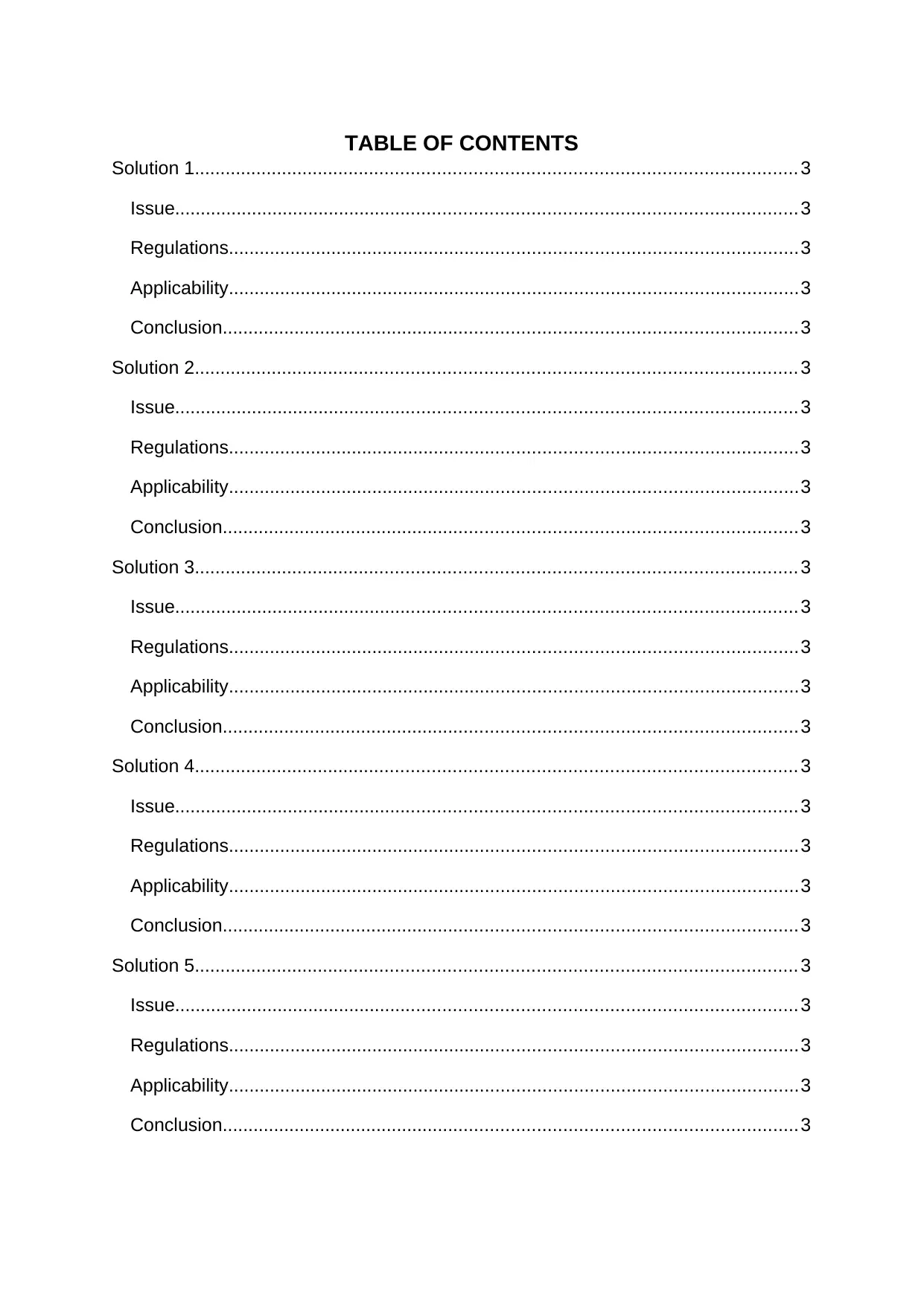
TABLE OF CONTENTS
Solution 1.................................................................................................................... 3
Issue........................................................................................................................ 3
Regulations..............................................................................................................3
Applicability..............................................................................................................3
Conclusion...............................................................................................................3
Solution 2.................................................................................................................... 3
Issue........................................................................................................................ 3
Regulations..............................................................................................................3
Applicability..............................................................................................................3
Conclusion...............................................................................................................3
Solution 3.................................................................................................................... 3
Issue........................................................................................................................ 3
Regulations..............................................................................................................3
Applicability..............................................................................................................3
Conclusion...............................................................................................................3
Solution 4.................................................................................................................... 3
Issue........................................................................................................................ 3
Regulations..............................................................................................................3
Applicability..............................................................................................................3
Conclusion...............................................................................................................3
Solution 5.................................................................................................................... 3
Issue........................................................................................................................ 3
Regulations..............................................................................................................3
Applicability..............................................................................................................3
Conclusion...............................................................................................................3
Solution 1.................................................................................................................... 3
Issue........................................................................................................................ 3
Regulations..............................................................................................................3
Applicability..............................................................................................................3
Conclusion...............................................................................................................3
Solution 2.................................................................................................................... 3
Issue........................................................................................................................ 3
Regulations..............................................................................................................3
Applicability..............................................................................................................3
Conclusion...............................................................................................................3
Solution 3.................................................................................................................... 3
Issue........................................................................................................................ 3
Regulations..............................................................................................................3
Applicability..............................................................................................................3
Conclusion...............................................................................................................3
Solution 4.................................................................................................................... 3
Issue........................................................................................................................ 3
Regulations..............................................................................................................3
Applicability..............................................................................................................3
Conclusion...............................................................................................................3
Solution 5.................................................................................................................... 3
Issue........................................................................................................................ 3
Regulations..............................................................................................................3
Applicability..............................................................................................................3
Conclusion...............................................................................................................3
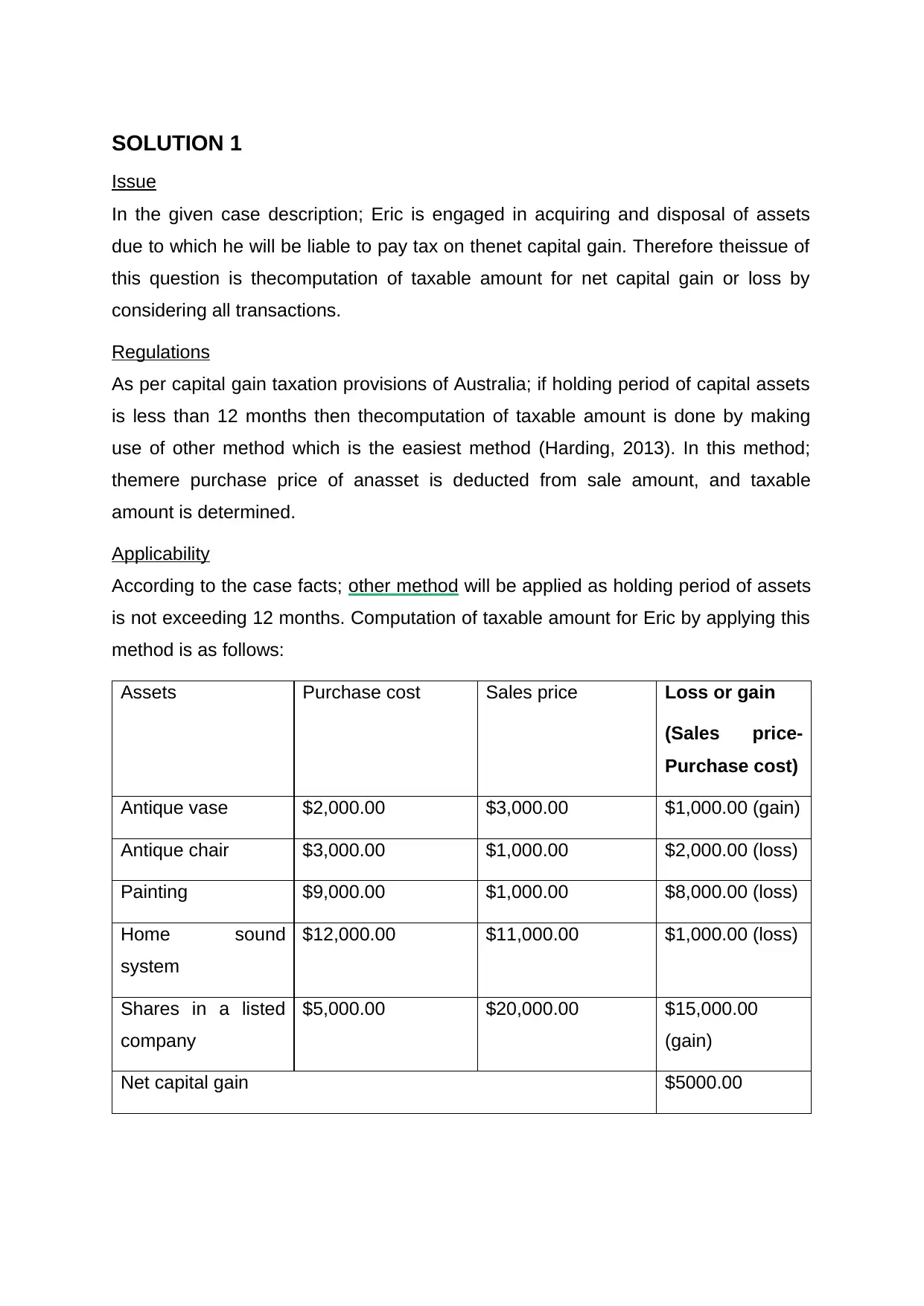
SOLUTION 1
Issue
In the given case description; Eric is engaged in acquiring and disposal of assets
due to which he will be liable to pay tax on thenet capital gain. Therefore theissue of
this question is thecomputation of taxable amount for net capital gain or loss by
considering all transactions.
Regulations
As per capital gain taxation provisions of Australia; if holding period of capital assets
is less than 12 months then thecomputation of taxable amount is done by making
use of other method which is the easiest method (Harding, 2013). In this method;
themere purchase price of anasset is deducted from sale amount, and taxable
amount is determined.
Applicability
According to the case facts; other method will be applied as holding period of assets
is not exceeding 12 months. Computation of taxable amount for Eric by applying this
method is as follows:
Assets Purchase cost Sales price Loss or gain
(Sales price-
Purchase cost)
Antique vase $2,000.00 $3,000.00 $1,000.00 (gain)
Antique chair $3,000.00 $1,000.00 $2,000.00 (loss)
Painting $9,000.00 $1,000.00 $8,000.00 (loss)
Home sound
system
$12,000.00 $11,000.00 $1,000.00 (loss)
Shares in a listed
company
$5,000.00 $20,000.00 $15,000.00
(gain)
Net capital gain $5000.00
Issue
In the given case description; Eric is engaged in acquiring and disposal of assets
due to which he will be liable to pay tax on thenet capital gain. Therefore theissue of
this question is thecomputation of taxable amount for net capital gain or loss by
considering all transactions.
Regulations
As per capital gain taxation provisions of Australia; if holding period of capital assets
is less than 12 months then thecomputation of taxable amount is done by making
use of other method which is the easiest method (Harding, 2013). In this method;
themere purchase price of anasset is deducted from sale amount, and taxable
amount is determined.
Applicability
According to the case facts; other method will be applied as holding period of assets
is not exceeding 12 months. Computation of taxable amount for Eric by applying this
method is as follows:
Assets Purchase cost Sales price Loss or gain
(Sales price-
Purchase cost)
Antique vase $2,000.00 $3,000.00 $1,000.00 (gain)
Antique chair $3,000.00 $1,000.00 $2,000.00 (loss)
Painting $9,000.00 $1,000.00 $8,000.00 (loss)
Home sound
system
$12,000.00 $11,000.00 $1,000.00 (loss)
Shares in a listed
company
$5,000.00 $20,000.00 $15,000.00
(gain)
Net capital gain $5000.00
⊘ This is a preview!⊘
Do you want full access?
Subscribe today to unlock all pages.

Trusted by 1+ million students worldwide
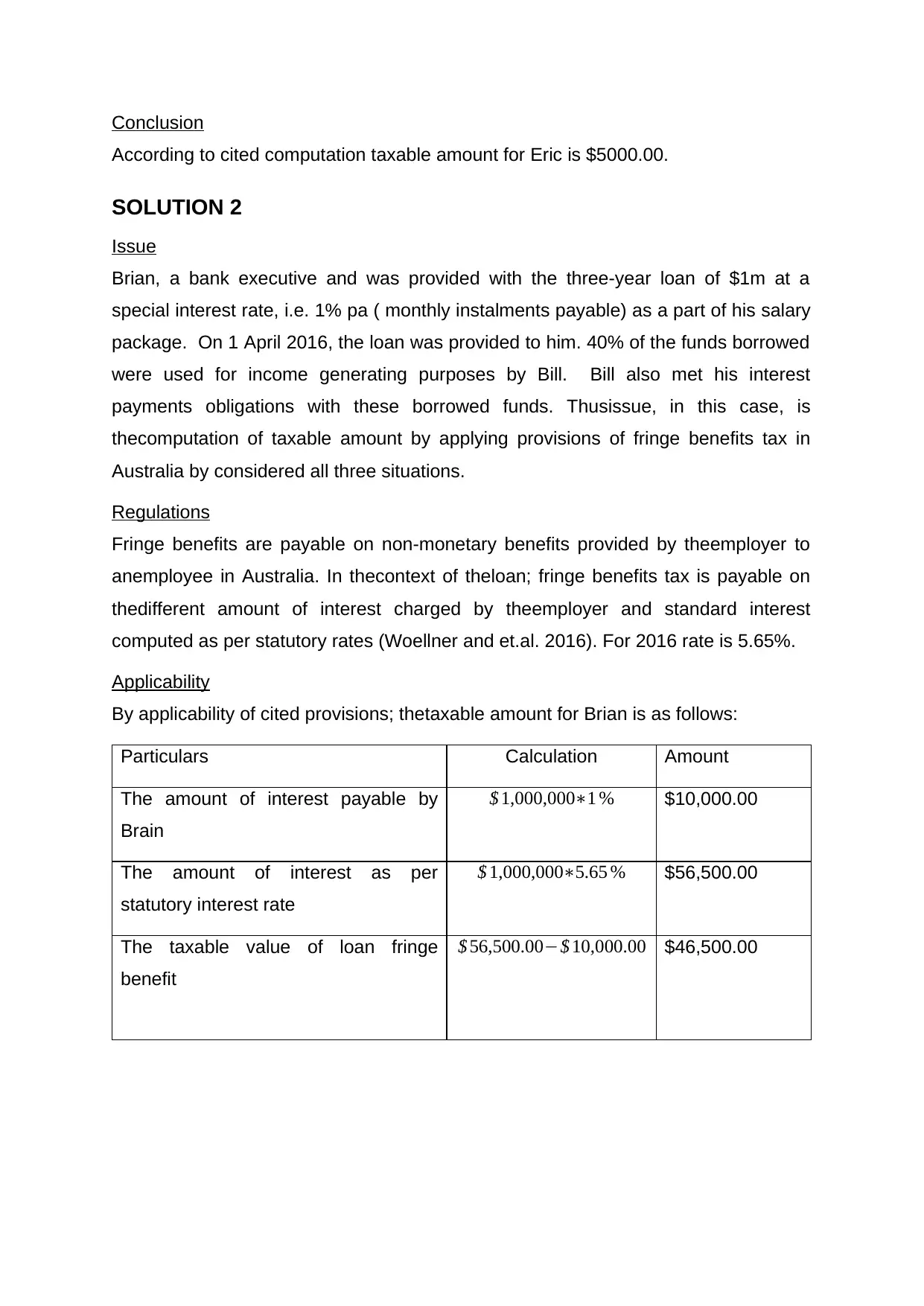
Conclusion
According to cited computation taxable amount for Eric is $5000.00.
SOLUTION 2
Issue
Brian, a bank executive and was provided with the three-year loan of $1m at a
special interest rate, i.e. 1% pa ( monthly instalments payable) as a part of his salary
package. On 1 April 2016, the loan was provided to him. 40% of the funds borrowed
were used for income generating purposes by Bill. Bill also met his interest
payments obligations with these borrowed funds. Thusissue, in this case, is
thecomputation of taxable amount by applying provisions of fringe benefits tax in
Australia by considered all three situations.
Regulations
Fringe benefits are payable on non-monetary benefits provided by theemployer to
anemployee in Australia. In thecontext of theloan; fringe benefits tax is payable on
thedifferent amount of interest charged by theemployer and standard interest
computed as per statutory rates (Woellner and et.al. 2016). For 2016 rate is 5.65%.
Applicability
By applicability of cited provisions; thetaxable amount for Brian is as follows:
Particulars Calculation Amount
The amount of interest payable by
Brain
$ 1,000,000∗1 % $10,000.00
The amount of interest as per
statutory interest rate
$ 1,000,000∗5.65 % $56,500.00
The taxable value of loan fringe
benefit
$ 56,500.00−$ 10,000.00 $46,500.00
According to cited computation taxable amount for Eric is $5000.00.
SOLUTION 2
Issue
Brian, a bank executive and was provided with the three-year loan of $1m at a
special interest rate, i.e. 1% pa ( monthly instalments payable) as a part of his salary
package. On 1 April 2016, the loan was provided to him. 40% of the funds borrowed
were used for income generating purposes by Bill. Bill also met his interest
payments obligations with these borrowed funds. Thusissue, in this case, is
thecomputation of taxable amount by applying provisions of fringe benefits tax in
Australia by considered all three situations.
Regulations
Fringe benefits are payable on non-monetary benefits provided by theemployer to
anemployee in Australia. In thecontext of theloan; fringe benefits tax is payable on
thedifferent amount of interest charged by theemployer and standard interest
computed as per statutory rates (Woellner and et.al. 2016). For 2016 rate is 5.65%.
Applicability
By applicability of cited provisions; thetaxable amount for Brian is as follows:
Particulars Calculation Amount
The amount of interest payable by
Brain
$ 1,000,000∗1 % $10,000.00
The amount of interest as per
statutory interest rate
$ 1,000,000∗5.65 % $56,500.00
The taxable value of loan fringe
benefit
$ 56,500.00−$ 10,000.00 $46,500.00
Paraphrase This Document
Need a fresh take? Get an instant paraphrase of this document with our AI Paraphraser
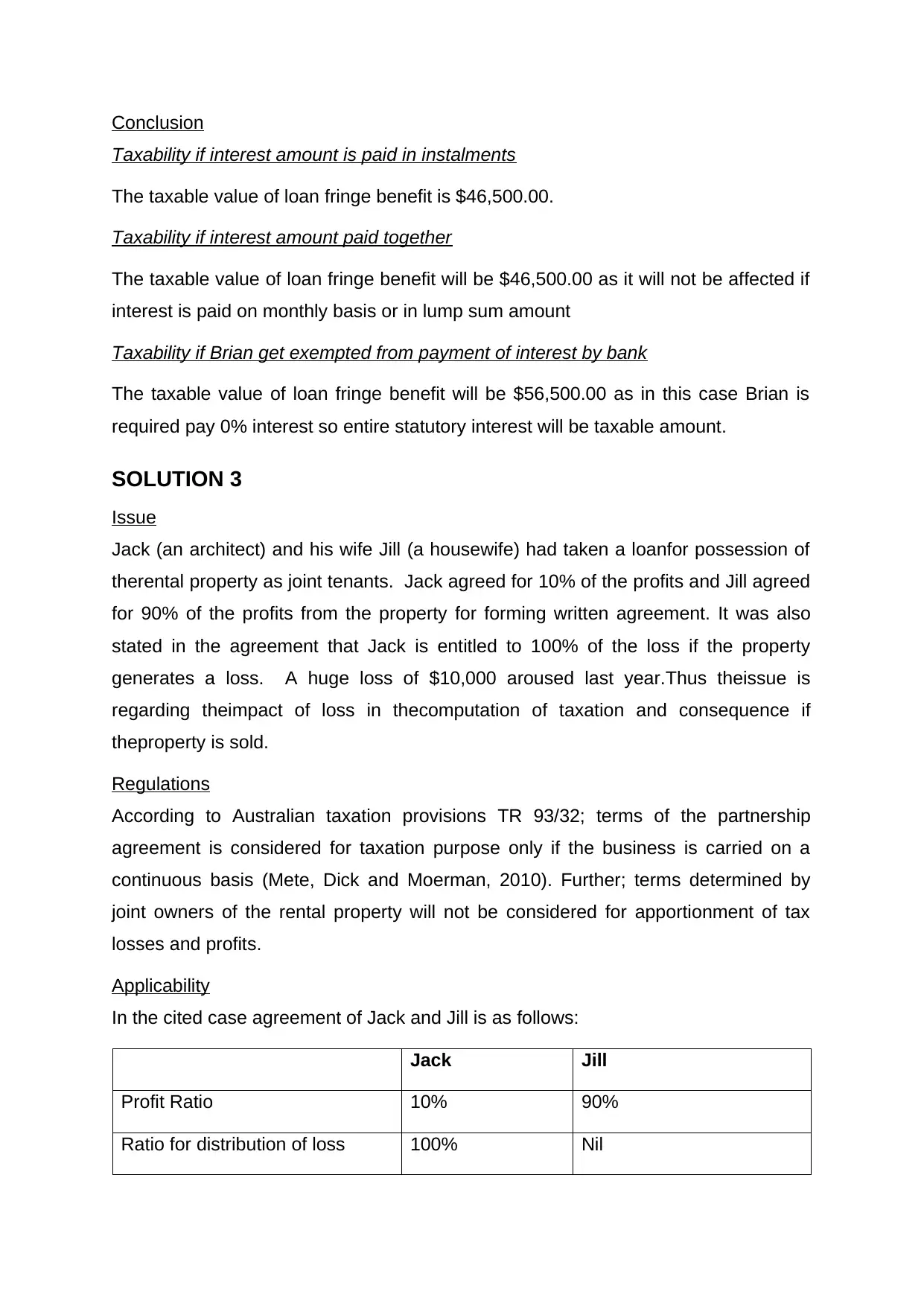
Conclusion
Taxability if interest amount is paid in instalments
The taxable value of loan fringe benefit is $46,500.00.
Taxability if interest amount paid together
The taxable value of loan fringe benefit will be $46,500.00 as it will not be affected if
interest is paid on monthly basis or in lump sum amount
Taxability if Brian get exempted from payment of interest by bank
The taxable value of loan fringe benefit will be $56,500.00 as in this case Brian is
required pay 0% interest so entire statutory interest will be taxable amount.
SOLUTION 3
Issue
Jack (an architect) and his wife Jill (a housewife) had taken a loanfor possession of
therental property as joint tenants. Jack agreed for 10% of the profits and Jill agreed
for 90% of the profits from the property for forming written agreement. It was also
stated in the agreement that Jack is entitled to 100% of the loss if the property
generates a loss. A huge loss of $10,000 aroused last year.Thus theissue is
regarding theimpact of loss in thecomputation of taxation and consequence if
theproperty is sold.
Regulations
According to Australian taxation provisions TR 93/32; terms of the partnership
agreement is considered for taxation purpose only if the business is carried on a
continuous basis (Mete, Dick and Moerman, 2010). Further; terms determined by
joint owners of the rental property will not be considered for apportionment of tax
losses and profits.
Applicability
In the cited case agreement of Jack and Jill is as follows:
Jack Jill
Profit Ratio 10% 90%
Ratio for distribution of loss 100% Nil
Taxability if interest amount is paid in instalments
The taxable value of loan fringe benefit is $46,500.00.
Taxability if interest amount paid together
The taxable value of loan fringe benefit will be $46,500.00 as it will not be affected if
interest is paid on monthly basis or in lump sum amount
Taxability if Brian get exempted from payment of interest by bank
The taxable value of loan fringe benefit will be $56,500.00 as in this case Brian is
required pay 0% interest so entire statutory interest will be taxable amount.
SOLUTION 3
Issue
Jack (an architect) and his wife Jill (a housewife) had taken a loanfor possession of
therental property as joint tenants. Jack agreed for 10% of the profits and Jill agreed
for 90% of the profits from the property for forming written agreement. It was also
stated in the agreement that Jack is entitled to 100% of the loss if the property
generates a loss. A huge loss of $10,000 aroused last year.Thus theissue is
regarding theimpact of loss in thecomputation of taxation and consequence if
theproperty is sold.
Regulations
According to Australian taxation provisions TR 93/32; terms of the partnership
agreement is considered for taxation purpose only if the business is carried on a
continuous basis (Mete, Dick and Moerman, 2010). Further; terms determined by
joint owners of the rental property will not be considered for apportionment of tax
losses and profits.
Applicability
In the cited case agreement of Jack and Jill is as follows:
Jack Jill
Profit Ratio 10% 90%
Ratio for distribution of loss 100% Nil
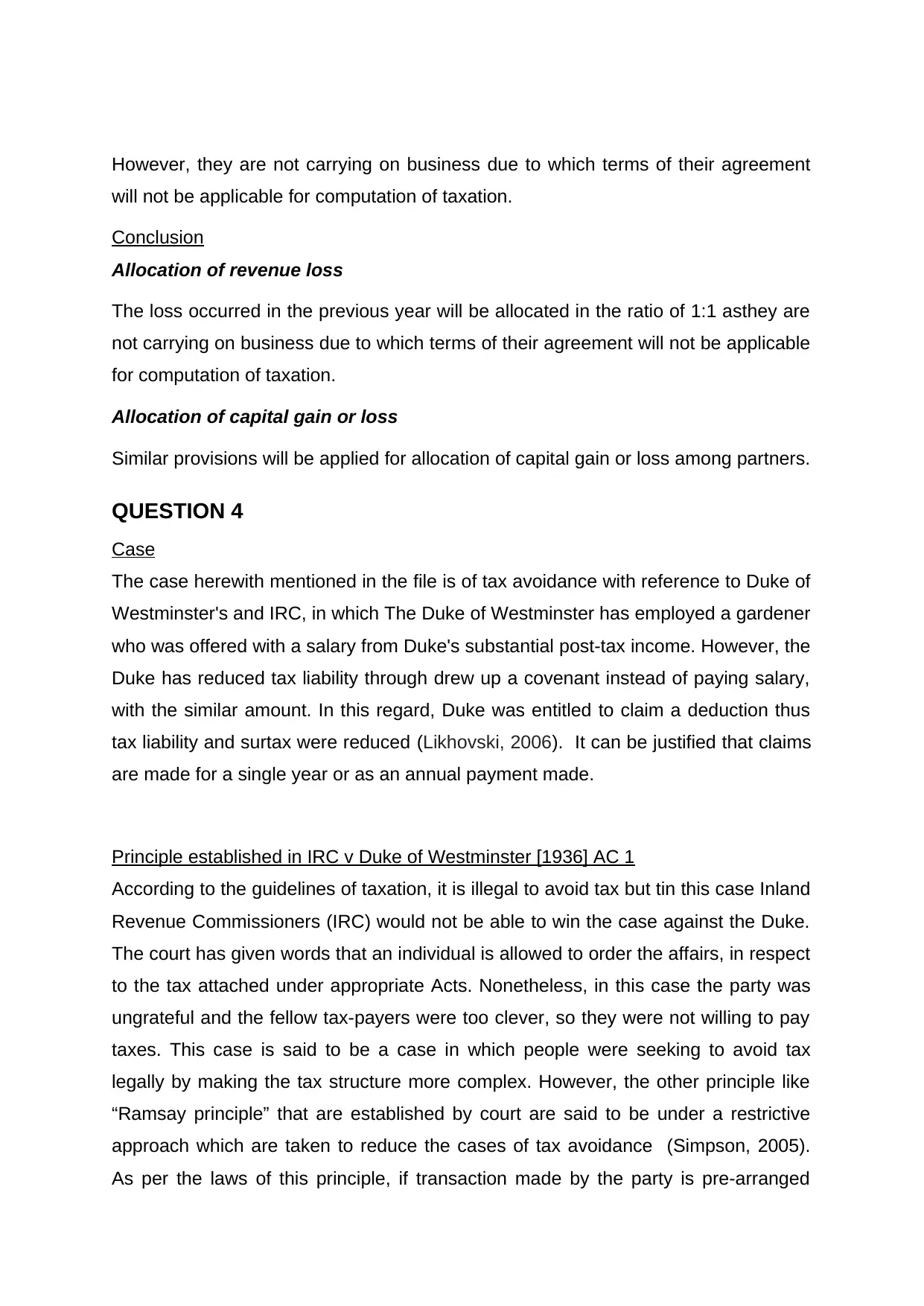
However, they are not carrying on business due to which terms of their agreement
will not be applicable for computation of taxation.
Conclusion
Allocation of revenue loss
The loss occurred in the previous year will be allocated in the ratio of 1:1 asthey are
not carrying on business due to which terms of their agreement will not be applicable
for computation of taxation.
Allocation of capital gain or loss
Similar provisions will be applied for allocation of capital gain or loss among partners.
QUESTION 4
Case
The case herewith mentioned in the file is of tax avoidance with reference to Duke of
Westminster's and IRC, in which The Duke of Westminster has employed a gardener
who was offered with a salary from Duke's substantial post-tax income. However, the
Duke has reduced tax liability through drew up a covenant instead of paying salary,
with the similar amount. In this regard, Duke was entitled to claim a deduction thus
tax liability and surtax were reduced (Likhovski, 2006). It can be justified that claims
are made for a single year or as an annual payment made.
Principle established in IRC v Duke of Westminster [1936] AC 1
According to the guidelines of taxation, it is illegal to avoid tax but tin this case Inland
Revenue Commissioners (IRC) would not be able to win the case against the Duke.
The court has given words that an individual is allowed to order the affairs, in respect
to the tax attached under appropriate Acts. Nonetheless, in this case the party was
ungrateful and the fellow tax-payers were too clever, so they were not willing to pay
taxes. This case is said to be a case in which people were seeking to avoid tax
legally by making the tax structure more complex. However, the other principle like
“Ramsay principle” that are established by court are said to be under a restrictive
approach which are taken to reduce the cases of tax avoidance (Simpson, 2005).
As per the laws of this principle, if transaction made by the party is pre-arranged
will not be applicable for computation of taxation.
Conclusion
Allocation of revenue loss
The loss occurred in the previous year will be allocated in the ratio of 1:1 asthey are
not carrying on business due to which terms of their agreement will not be applicable
for computation of taxation.
Allocation of capital gain or loss
Similar provisions will be applied for allocation of capital gain or loss among partners.
QUESTION 4
Case
The case herewith mentioned in the file is of tax avoidance with reference to Duke of
Westminster's and IRC, in which The Duke of Westminster has employed a gardener
who was offered with a salary from Duke's substantial post-tax income. However, the
Duke has reduced tax liability through drew up a covenant instead of paying salary,
with the similar amount. In this regard, Duke was entitled to claim a deduction thus
tax liability and surtax were reduced (Likhovski, 2006). It can be justified that claims
are made for a single year or as an annual payment made.
Principle established in IRC v Duke of Westminster [1936] AC 1
According to the guidelines of taxation, it is illegal to avoid tax but tin this case Inland
Revenue Commissioners (IRC) would not be able to win the case against the Duke.
The court has given words that an individual is allowed to order the affairs, in respect
to the tax attached under appropriate Acts. Nonetheless, in this case the party was
ungrateful and the fellow tax-payers were too clever, so they were not willing to pay
taxes. This case is said to be a case in which people were seeking to avoid tax
legally by making the tax structure more complex. However, the other principle like
“Ramsay principle” that are established by court are said to be under a restrictive
approach which are taken to reduce the cases of tax avoidance (Simpson, 2005).
As per the laws of this principle, if transaction made by the party is pre-arranged
⊘ This is a preview!⊘
Do you want full access?
Subscribe today to unlock all pages.

Trusted by 1+ million students worldwide
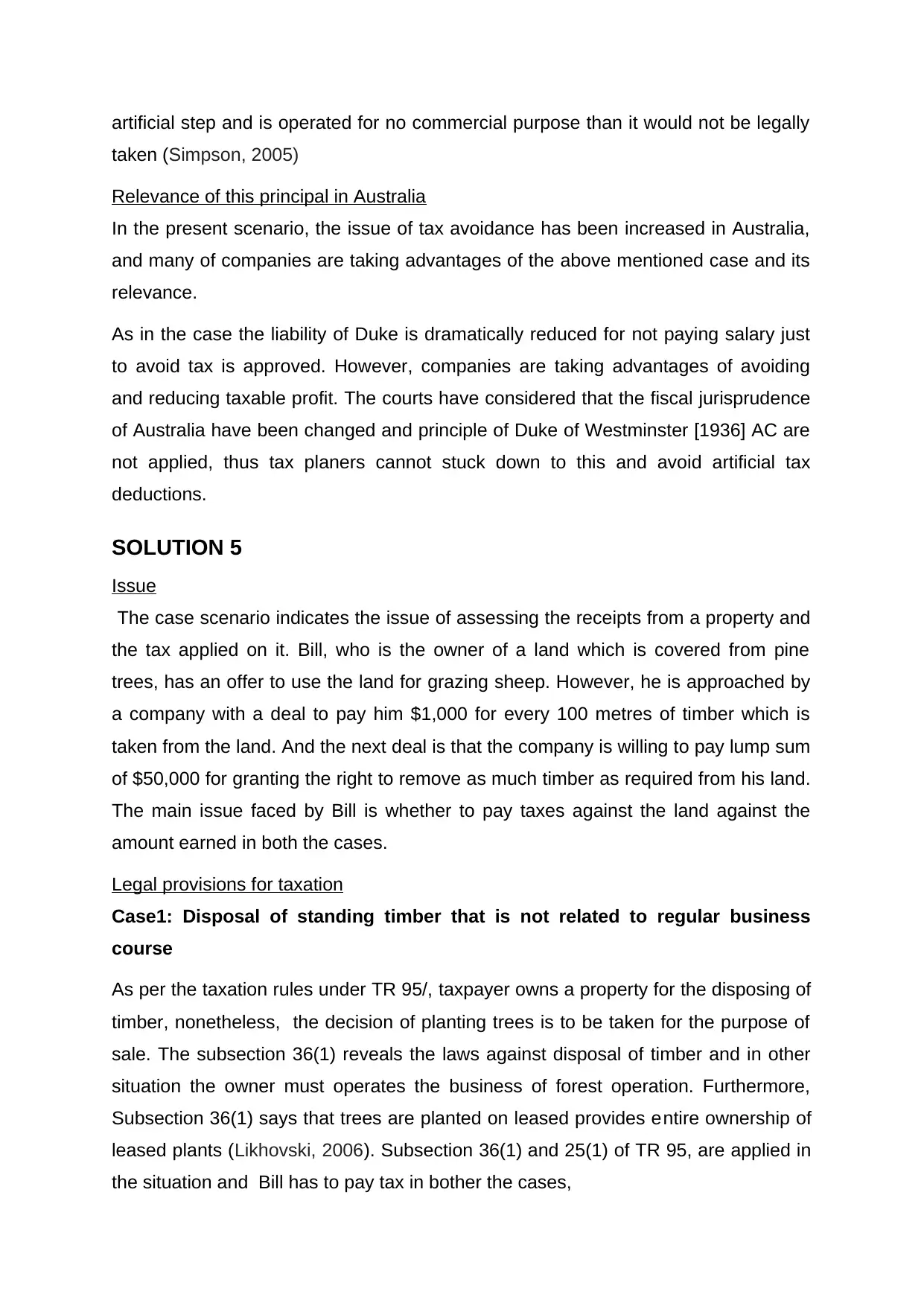
artificial step and is operated for no commercial purpose than it would not be legally
taken (Simpson, 2005)
Relevance of this principal in Australia
In the present scenario, the issue of tax avoidance has been increased in Australia,
and many of companies are taking advantages of the above mentioned case and its
relevance.
As in the case the liability of Duke is dramatically reduced for not paying salary just
to avoid tax is approved. However, companies are taking advantages of avoiding
and reducing taxable profit. The courts have considered that the fiscal jurisprudence
of Australia have been changed and principle of Duke of Westminster [1936] AC are
not applied, thus tax planers cannot stuck down to this and avoid artificial tax
deductions.
SOLUTION 5
Issue
The case scenario indicates the issue of assessing the receipts from a property and
the tax applied on it. Bill, who is the owner of a land which is covered from pine
trees, has an offer to use the land for grazing sheep. However, he is approached by
a company with a deal to pay him $1,000 for every 100 metres of timber which is
taken from the land. And the next deal is that the company is willing to pay lump sum
of $50,000 for granting the right to remove as much timber as required from his land.
The main issue faced by Bill is whether to pay taxes against the land against the
amount earned in both the cases.
Legal provisions for taxation
Case1: Disposal of standing timber that is not related to regular business
course
As per the taxation rules under TR 95/, taxpayer owns a property for the disposing of
timber, nonetheless, the decision of planting trees is to be taken for the purpose of
sale. The subsection 36(1) reveals the laws against disposal of timber and in other
situation the owner must operates the business of forest operation. Furthermore,
Subsection 36(1) says that trees are planted on leased provides entire ownership of
leased plants (Likhovski, 2006). Subsection 36(1) and 25(1) of TR 95, are applied in
the situation and Bill has to pay tax in bother the cases,
taken (Simpson, 2005)
Relevance of this principal in Australia
In the present scenario, the issue of tax avoidance has been increased in Australia,
and many of companies are taking advantages of the above mentioned case and its
relevance.
As in the case the liability of Duke is dramatically reduced for not paying salary just
to avoid tax is approved. However, companies are taking advantages of avoiding
and reducing taxable profit. The courts have considered that the fiscal jurisprudence
of Australia have been changed and principle of Duke of Westminster [1936] AC are
not applied, thus tax planers cannot stuck down to this and avoid artificial tax
deductions.
SOLUTION 5
Issue
The case scenario indicates the issue of assessing the receipts from a property and
the tax applied on it. Bill, who is the owner of a land which is covered from pine
trees, has an offer to use the land for grazing sheep. However, he is approached by
a company with a deal to pay him $1,000 for every 100 metres of timber which is
taken from the land. And the next deal is that the company is willing to pay lump sum
of $50,000 for granting the right to remove as much timber as required from his land.
The main issue faced by Bill is whether to pay taxes against the land against the
amount earned in both the cases.
Legal provisions for taxation
Case1: Disposal of standing timber that is not related to regular business
course
As per the taxation rules under TR 95/, taxpayer owns a property for the disposing of
timber, nonetheless, the decision of planting trees is to be taken for the purpose of
sale. The subsection 36(1) reveals the laws against disposal of timber and in other
situation the owner must operates the business of forest operation. Furthermore,
Subsection 36(1) says that trees are planted on leased provides entire ownership of
leased plants (Likhovski, 2006). Subsection 36(1) and 25(1) of TR 95, are applied in
the situation and Bill has to pay tax in bother the cases,
Paraphrase This Document
Need a fresh take? Get an instant paraphrase of this document with our AI Paraphraser
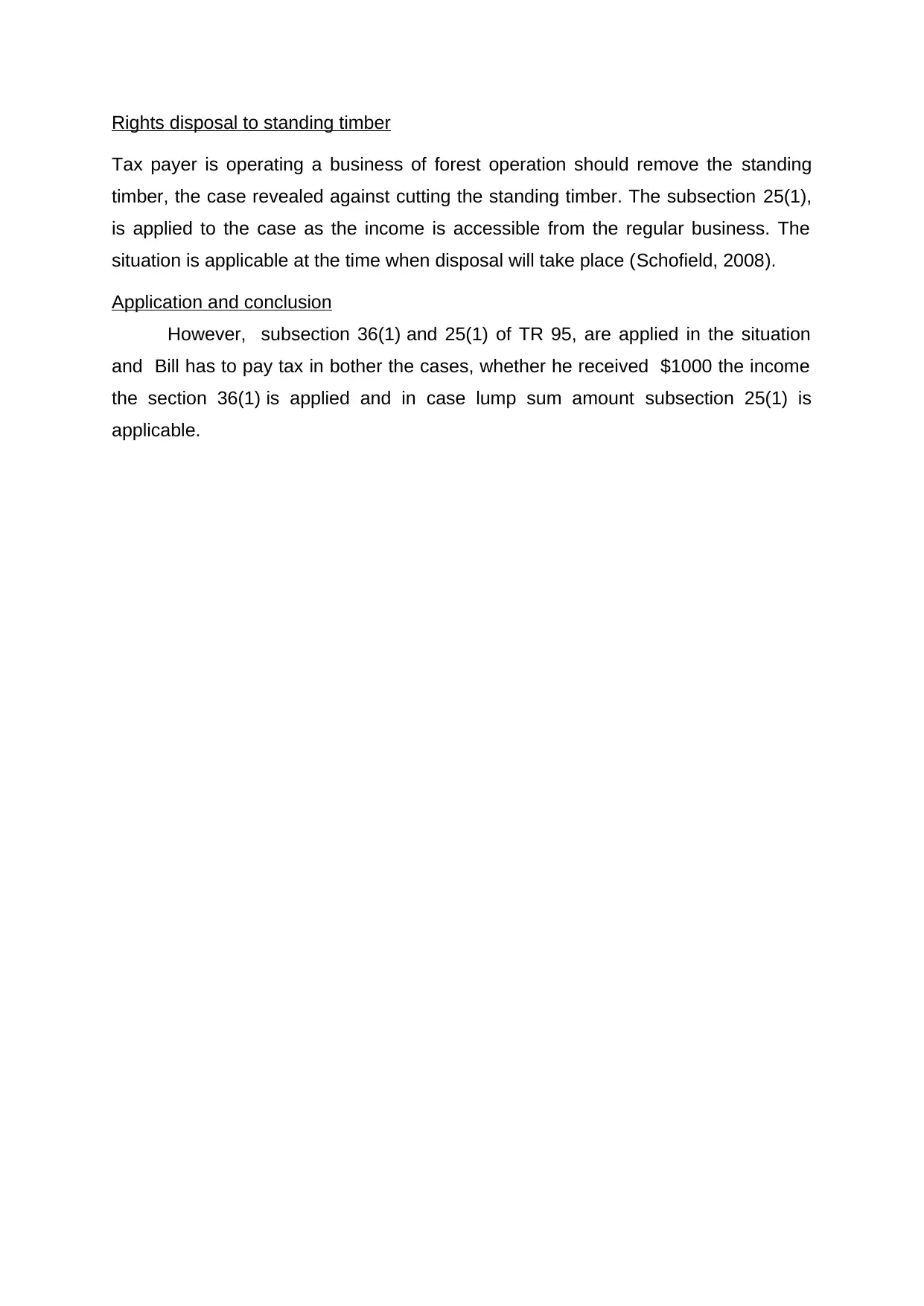
Rights disposal to standing timber
Tax payer is operating a business of forest operation should remove the standing
timber, the case revealed against cutting the standing timber. The subsection 25(1),
is applied to the case as the income is accessible from the regular business. The
situation is applicable at the time when disposal will take place (Schofield, 2008).
Application and conclusion
However, subsection 36(1) and 25(1) of TR 95, are applied in the situation
and Bill has to pay tax in bother the cases, whether he received $1000 the income
the section 36(1) is applied and in case lump sum amount subsection 25(1) is
applicable.
Tax payer is operating a business of forest operation should remove the standing
timber, the case revealed against cutting the standing timber. The subsection 25(1),
is applied to the case as the income is accessible from the regular business. The
situation is applicable at the time when disposal will take place (Schofield, 2008).
Application and conclusion
However, subsection 36(1) and 25(1) of TR 95, are applied in the situation
and Bill has to pay tax in bother the cases, whether he received $1000 the income
the section 36(1) is applied and in case lump sum amount subsection 25(1) is
applicable.
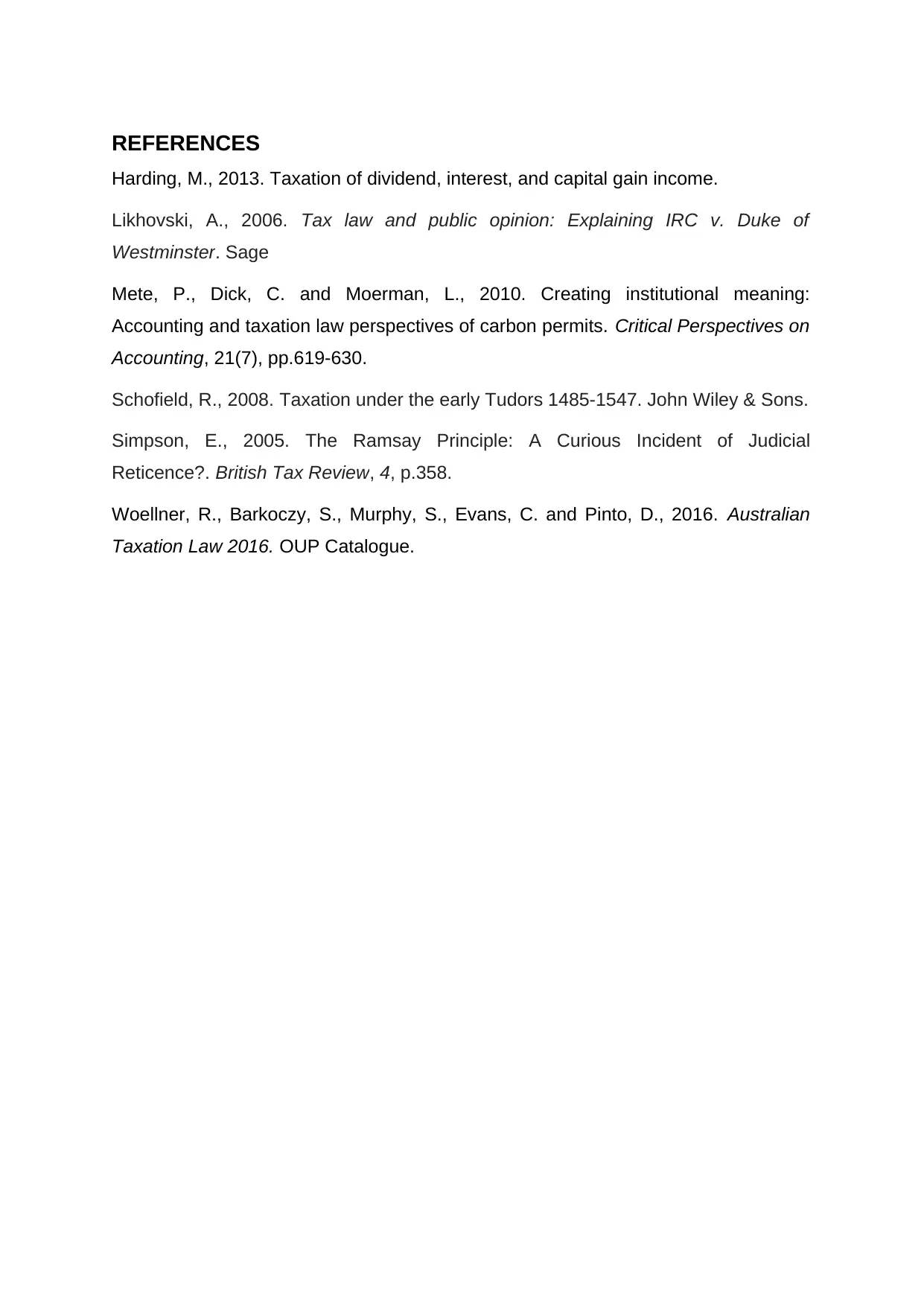
REFERENCES
Harding, M., 2013. Taxation of dividend, interest, and capital gain income.
Likhovski, A., 2006. Tax law and public opinion: Explaining IRC v. Duke of
Westminster. Sage
Mete, P., Dick, C. and Moerman, L., 2010. Creating institutional meaning:
Accounting and taxation law perspectives of carbon permits. Critical Perspectives on
Accounting, 21(7), pp.619-630.
Schofield, R., 2008. Taxation under the early Tudors 1485-1547. John Wiley & Sons.
Simpson, E., 2005. The Ramsay Principle: A Curious Incident of Judicial
Reticence?. British Tax Review, 4, p.358.
Woellner, R., Barkoczy, S., Murphy, S., Evans, C. and Pinto, D., 2016. Australian
Taxation Law 2016. OUP Catalogue.
Harding, M., 2013. Taxation of dividend, interest, and capital gain income.
Likhovski, A., 2006. Tax law and public opinion: Explaining IRC v. Duke of
Westminster. Sage
Mete, P., Dick, C. and Moerman, L., 2010. Creating institutional meaning:
Accounting and taxation law perspectives of carbon permits. Critical Perspectives on
Accounting, 21(7), pp.619-630.
Schofield, R., 2008. Taxation under the early Tudors 1485-1547. John Wiley & Sons.
Simpson, E., 2005. The Ramsay Principle: A Curious Incident of Judicial
Reticence?. British Tax Review, 4, p.358.
Woellner, R., Barkoczy, S., Murphy, S., Evans, C. and Pinto, D., 2016. Australian
Taxation Law 2016. OUP Catalogue.
⊘ This is a preview!⊘
Do you want full access?
Subscribe today to unlock all pages.

Trusted by 1+ million students worldwide
1 out of 9
Related Documents
Your All-in-One AI-Powered Toolkit for Academic Success.
+13062052269
info@desklib.com
Available 24*7 on WhatsApp / Email
![[object Object]](/_next/static/media/star-bottom.7253800d.svg)
Unlock your academic potential
Copyright © 2020–2025 A2Z Services. All Rights Reserved. Developed and managed by ZUCOL.





